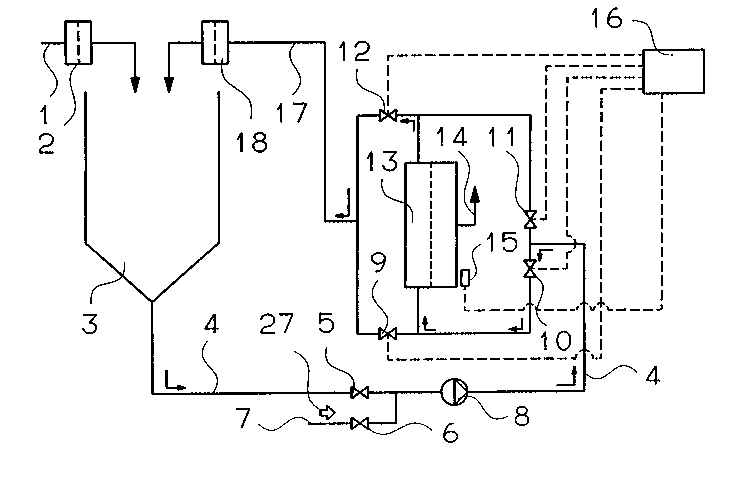Une partie des informations de ce site Web a été fournie par des sources externes. Le gouvernement du Canada n'assume aucune responsabilité concernant la précision, l'actualité ou la fiabilité des informations fournies par les sources externes. Les utilisateurs qui désirent employer cette information devraient consulter directement la source des informations. Le contenu fourni par les sources externes n'est pas assujetti aux exigences sur les langues officielles, la protection des renseignements personnels et l'accessibilité.
L'apparition de différences dans le texte et l'image des Revendications et de l'Abrégé dépend du moment auquel le document est publié. Les textes des Revendications et de l'Abrégé sont affichés :
| (12) Demande de brevet: | (11) CA 2141846 |
|---|---|
| (54) Titre français: | PROCEDE POUR LE NETTOYAGE DE FILTRES MODULAIRES UTILISES DANS UNE INSTALLATION D'EPURATION DE LIQUIDES |
| (54) Titre anglais: | PROCESS FOR CLEANING THE FILTER MODULES OF A PLANT FOR PURIFYING LIQUIDS |
| Statut: | Réputée abandonnée et au-delà du délai pour le rétablissement - en attente de la réponse à l’avis de communication rejetée |
| (51) Classification internationale des brevets (CIB): |
|
|---|---|
| (72) Inventeurs : |
|
| (73) Titulaires : |
|
| (71) Demandeurs : |
|
| (74) Agent: | OSLER, HOSKIN & HARCOURT LLP |
| (74) Co-agent: | |
| (45) Délivré: | |
| (86) Date de dépôt PCT: | 1994-06-02 |
| (87) Mise à la disponibilité du public: | 1994-12-22 |
| Licence disponible: | S.O. |
| Cédé au domaine public: | S.O. |
| (25) Langue des documents déposés: | Anglais |
| Traité de coopération en matière de brevets (PCT): | Oui |
|---|---|
| (86) Numéro de la demande PCT: | PCT/CH1994/000103 |
| (87) Numéro de publication internationale PCT: | WO 1994029007 |
| (85) Entrée nationale: | 1995-02-06 |
| (30) Données de priorité de la demande: | ||||||
|---|---|---|---|---|---|---|
|
Le procédé de nettoyage des modules de filtration (11) d'un dispositif de filtration à courant transversal est exécuté dans une installation servant à la décantation de liquides, en particulier ceux contenant une proportion élevée de fibres. L'accumulation continue de fibres pose des problèmes en pareil cas, principalement à l'entrée des modules de filtration (13) placés aux extrémités avant des canaux, accumulation qui peut conduire à des obturations. Pour détruire les accumulations de fibres, on inverse, pendant le nettoyage, le sens de l'écoulement dans le module (13) par rapport au cycle de filtration précédent. Cette action est opérée par l'enclenchement des vannes (9 à 12). L'inversion du sens d'écoulement pendant le nettoyage permet de dissoudre facilement les accumulations de fibres demeurées peu importantes et de les évacuer à l'extérieur des modules. On peut ainsi éviter l'obturation de ces modules.
ABSTRACT
The process for cleaning the filtration modules (13)
of a cross-current filtration apparatus is carried out in a
system which is employed to clarify liquids, particularly
those with a high proportion of fiber. A problem in this
respect is the continuous accumulation of fibers, especially
at the entry to the filtration modules (13) at the face ends
of the various conduits, which can cause plugging. To
reduce the accumulations of fiber, when cleaning is done the
flow direction in the module (13) is reversed, compared with
the preceding filtration cycle. This is done by suitably
switching valves (9-12). Because of the reversal of the
flow direction flow cleaning, the fiber accumulations can be
easily detached while still small and flushed out of the
modules. Plugging up of the modules can thus be averted.
Note : Les revendications sont présentées dans la langue officielle dans laquelle elles ont été soumises.
Note : Les descriptions sont présentées dans la langue officielle dans laquelle elles ont été soumises.

2024-08-01 : Dans le cadre de la transition vers les Brevets de nouvelle génération (BNG), la base de données sur les brevets canadiens (BDBC) contient désormais un Historique d'événement plus détaillé, qui reproduit le Journal des événements de notre nouvelle solution interne.
Veuillez noter que les événements débutant par « Inactive : » se réfèrent à des événements qui ne sont plus utilisés dans notre nouvelle solution interne.
Pour une meilleure compréhension de l'état de la demande ou brevet qui figure sur cette page, la rubrique Mise en garde , et les descriptions de Brevet , Historique d'événement , Taxes périodiques et Historique des paiements devraient être consultées.
| Description | Date |
|---|---|
| Le délai pour l'annulation est expiré | 1997-06-02 |
| Demande non rétablie avant l'échéance | 1997-06-02 |
| Réputée abandonnée - omission de répondre à un avis sur les taxes pour le maintien en état | 1996-06-03 |
| Demande publiée (accessible au public) | 1994-12-22 |
| Date d'abandonnement | Raison | Date de rétablissement |
|---|---|---|
| 1996-06-03 |
Les titulaires actuels et antérieures au dossier sont affichés en ordre alphabétique.
| Titulaires actuels au dossier |
|---|
| BUCHER-GUYER AG MASCHINENFABRIK |
| Titulaires antérieures au dossier |
|---|
| EDUARD HARTMANN |